Dry Season Trip to Selous Game Reserve – Day 4
We started the second full field day with a trip to a drainage line about 1 km NNE of camp. The vehicles were parked at the pump station from which water is pumped up to camp, and the team followed the stream (which was mostly dry), for approximately 800 metres. The grassy valley bottom was lined by dense thickets, with species such as Syzygium guineense, Rauvolfia caffra, Keetia venosa and Vernonia colorata being common throughout. 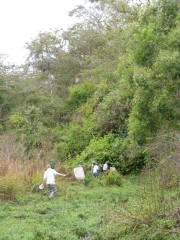 After a few hundred metres we entered a tall swamp forest that was dominated by Syzygium guineense and Shirakiopsis ellipticus, with other prominent trees being Erythrophloeum suaveolens, Rothmannia manganjae (in flower), Voacanga thouarsii and Pachystela brevipes. The swamp forest was a special place, even if it was not flooded at this time of the year. After following the forest trail for about 200 metres we entered another grassy valley bottom which is most likely an impressive wetland during the rain season. Two massive Milicia excelsa trees marked the edge of the wetland. Always a privilege to stand under these giants.
After a few hundred metres we entered a tall swamp forest that was dominated by Syzygium guineense and Shirakiopsis ellipticus, with other prominent trees being Erythrophloeum suaveolens, Rothmannia manganjae (in flower), Voacanga thouarsii and Pachystela brevipes. The swamp forest was a special place, even if it was not flooded at this time of the year. After following the forest trail for about 200 metres we entered another grassy valley bottom which is most likely an impressive wetland during the rain season. Two massive Milicia excelsa trees marked the edge of the wetland. Always a privilege to stand under these giants. 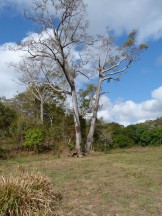 And to add to the pleasure, we were spoilt with great views of a pair of Brown-breasted Barbets perched in the leafless canopy. A cross-section profile of the valley vegetation was done and then we returned to the vehicles for lunch. Thankfully, Duncan spotted a small Uroplectes scorpion in the leaf litter before sitting on it! After lunch we drove back towards camp and then along the spine of a narrow ridge NE of camp and just to the east of the valley we had followed in the morning. The grassland along the ridge had recently burnt, making the floristic survey a bit complicated. However, several trees along the edge of the grassland were in full bloom, most notably Dombeya rotundifolia and Stereospermum kunthianum. Another highlight was a magnificent Leopard Orchid in full bloom in a dead tree.
And to add to the pleasure, we were spoilt with great views of a pair of Brown-breasted Barbets perched in the leafless canopy. A cross-section profile of the valley vegetation was done and then we returned to the vehicles for lunch. Thankfully, Duncan spotted a small Uroplectes scorpion in the leaf litter before sitting on it! After lunch we drove back towards camp and then along the spine of a narrow ridge NE of camp and just to the east of the valley we had followed in the morning. The grassland along the ridge had recently burnt, making the floristic survey a bit complicated. However, several trees along the edge of the grassland were in full bloom, most notably Dombeya rotundifolia and Stereospermum kunthianum. Another highlight was a magnificent Leopard Orchid in full bloom in a dead tree.  That rounded off a decent day in the field and an approaching thunderstorm sent us scurrying back to camp in the late afternoon. As was becoming the pattern, the day was ended with an evening beer on the platform looking west into the wilderness. What a life!
That rounded off a decent day in the field and an approaching thunderstorm sent us scurrying back to camp in the late afternoon. As was becoming the pattern, the day was ended with an evening beer on the platform looking west into the wilderness. What a life!
Dry Season Trip to Selous Game Reserve – Day Three
Our first full day in the field dawned. An excited group of ecologists loaded up in two Toyota Landcruisers and headed along a series of wooded ridges to the northern part of the project area. Within 30 minutes of leaving camp we came across one of the trip highlights…..a pack of African Wild Dogs with pups!! What an astounding start to the trip! The dogs played in the road in front of our vehicle, quite unafraid and in fact quite curious. I must have got about 20 great shots of the dogs before they were spooked by something and headed into the woodland. Does it get better than this??  As we headed north the vegetation changed from tall miombo woodland, i.e. woodland dominated by trees in the genera Brachystegia and Julbernardia, to tall, dense thickets dominated by Pteleopsis myrtifolia and Terminalia sambesiaca. The two vegetation types are very different in structure and plant composition, with very little species overlap. Consequently, the bird communities in each are very different and our arrival in the northern thickets was heralded by exotic bird calls such as Eastern Green Tinkerbird, African Broadbill and Eastern Nicator. We drove down one of the ridges to a northern tributary of the Mkuju River and parked in the forest along the river banks. A remarkable 4-5 hours were spent surveying the flora, birds, invertebrates and wetlands in this area. The first vegetation quadrat confirmed that this was a very interesting thicket type with more affinities with coastal thickets and lowland forest than the miombo woodland that it was embedded in. Some of the interesting species included the climbing Combretum pentagonum, Keetia sansibarica, Craibia zimmermannii and Leptactina platyphylla. One highlight was a massive Milicia excelsa tree that emerged at least 15 metres above the thicket canopy.
As we headed north the vegetation changed from tall miombo woodland, i.e. woodland dominated by trees in the genera Brachystegia and Julbernardia, to tall, dense thickets dominated by Pteleopsis myrtifolia and Terminalia sambesiaca. The two vegetation types are very different in structure and plant composition, with very little species overlap. Consequently, the bird communities in each are very different and our arrival in the northern thickets was heralded by exotic bird calls such as Eastern Green Tinkerbird, African Broadbill and Eastern Nicator. We drove down one of the ridges to a northern tributary of the Mkuju River and parked in the forest along the river banks. A remarkable 4-5 hours were spent surveying the flora, birds, invertebrates and wetlands in this area. The first vegetation quadrat confirmed that this was a very interesting thicket type with more affinities with coastal thickets and lowland forest than the miombo woodland that it was embedded in. Some of the interesting species included the climbing Combretum pentagonum, Keetia sansibarica, Craibia zimmermannii and Leptactina platyphylla. One highlight was a massive Milicia excelsa tree that emerged at least 15 metres above the thicket canopy. 
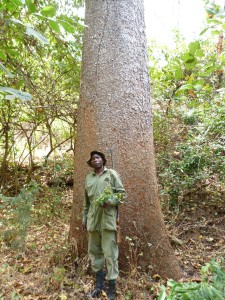 Evidence of regular Elephant traffic and some Buffalo spoor kept us as alert as possible, although we were accompanied by Wildlife Department guards whose senses were far more finely tuned than ours! A late lunch was eaten in the shade of the tall riparian thicket trees. An hour was then spent across the stream in similar thickets, part of which was trying to track down an elusive but very vocal Eastern Green Tinkerbird, to no avail! Our driver was then instructed to drive to a river crossing downstream where he would wait for us. We then set off along the stream bed on foot, spending some of the time crossing grassy wetlands and the rest in the thickets above the banks. A sinister buffalo skull was a reminder of what we needed to be alert for.
Evidence of regular Elephant traffic and some Buffalo spoor kept us as alert as possible, although we were accompanied by Wildlife Department guards whose senses were far more finely tuned than ours! A late lunch was eaten in the shade of the tall riparian thicket trees. An hour was then spent across the stream in similar thickets, part of which was trying to track down an elusive but very vocal Eastern Green Tinkerbird, to no avail! Our driver was then instructed to drive to a river crossing downstream where he would wait for us. We then set off along the stream bed on foot, spending some of the time crossing grassy wetlands and the rest in the thickets above the banks. A sinister buffalo skull was a reminder of what we needed to be alert for.  We arrived at the stream crossing as the sun was dipping towards the horizon and met up with the invertebrate survey team. It was the end of a very productive day and time to head back to camp to enjoy a cold drink on the viewing platform.
We arrived at the stream crossing as the sun was dipping towards the horizon and met up with the invertebrate survey team. It was the end of a very productive day and time to head back to camp to enjoy a cold drink on the viewing platform.
Dry Season Trip to Selous Game Reserve – Day Two
An early start saw us driving along remarkably quiet roads through Dar-es-Salaam…quite a contrast from last night! We arrived on time at Terminal 2 and checked in with the charter flight company that would be flying us to Likuyu. After a short wait in the departure hall we walked across the tarmac to our aircraft and boarded. Excitement was tangible. For everyone except myself, this was the first visit to the Selous, and I did not get to see that much in August anyway. This was going to be a trip of a lifetime. 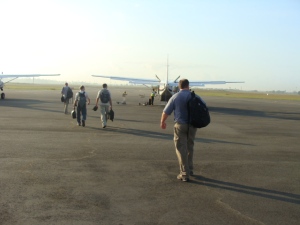 The charter flight from Dar to Likuyu crosses the length of the Selous from north-east to south-west and gives the viewer some perspective of the vast wilderness and astounding variety of habitats present. We touched down at Likuyu at about 09h30, pleased to see that our vehicles were waiting. The drive through the forest reserve adjacent to the Selous was a pleasant one, especially since much of the road had been graded since my last visit. A recent burn had stimulated the small suffrutex Cryptosepalum maraviense to initiate flowering and some parts of the woodland in the first part of the drive were covered in pale lilac blossoms in among the dry leaf litter. Unfortunately, we couldn’t stop for a photograph. We arrived at Mkuju Camp just before lunch and settled in.
The charter flight from Dar to Likuyu crosses the length of the Selous from north-east to south-west and gives the viewer some perspective of the vast wilderness and astounding variety of habitats present. We touched down at Likuyu at about 09h30, pleased to see that our vehicles were waiting. The drive through the forest reserve adjacent to the Selous was a pleasant one, especially since much of the road had been graded since my last visit. A recent burn had stimulated the small suffrutex Cryptosepalum maraviense to initiate flowering and some parts of the woodland in the first part of the drive were covered in pale lilac blossoms in among the dry leaf litter. Unfortunately, we couldn’t stop for a photograph. We arrived at Mkuju Camp just before lunch and settled in. 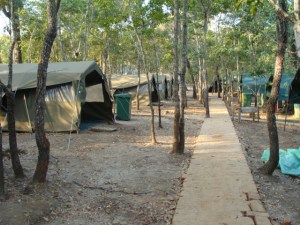 The camp is really well organised and we could see that this was going to set the bar for trips elsewhere in Africa! After lunch we endured the obligatory induction and then spread our maps out on the viewing platform to plan the week’s fieldwork.
The camp is really well organised and we could see that this was going to set the bar for trips elsewhere in Africa! After lunch we endured the obligatory induction and then spread our maps out on the viewing platform to plan the week’s fieldwork. 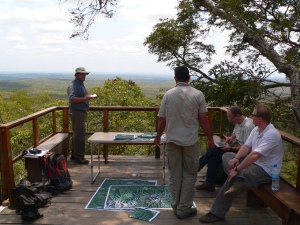 An afternoon drive into the northern part of the project area provided a decent introduction to some of the habitats that we would be working in. A highlight of this drive was the little orchid Polystachya dendrobiflora, which is usually an epiphyte on tall woodland trees, but here in the Selous it grows as a self-supporting species on eroded uranium-enriched crests.
An afternoon drive into the northern part of the project area provided a decent introduction to some of the habitats that we would be working in. A highlight of this drive was the little orchid Polystachya dendrobiflora, which is usually an epiphyte on tall woodland trees, but here in the Selous it grows as a self-supporting species on eroded uranium-enriched crests. 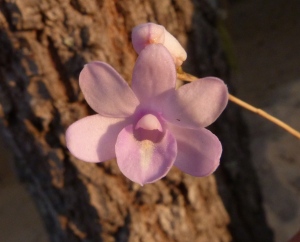
Dry Season Trip to Selous Game Reserve – Day One
The trip we had been waiting for has finally arrived! The start of the biodiversity baseline survey of the Mkuju Uranium Mine project area in Selous Game Reserve, south-central Tanzania. The Biodiversity Survey Team, comprising myself (flora, vertebrate fauna), Duncan McKenzie (vertebrate fauna), Peter Hawkes and Jonathan Fisher (invertebrates), met up with Alan Cochrane from Epoch Resources and Doug McCullough (wetland specialist) at O.R. Thambo International Airport. A mix-up with Doug meant we were seriously running late and we just managed to make the flight to Dar-es-Salaam. We arrived after dark and we treated to our first experience (for some) of the noisy, insane chaos that is Dar traffic. The drive to our hotel was a blur of lights, noise and strange smells. Cold beers were followed by a hearty meal, leaving us ready for a good night sleep.